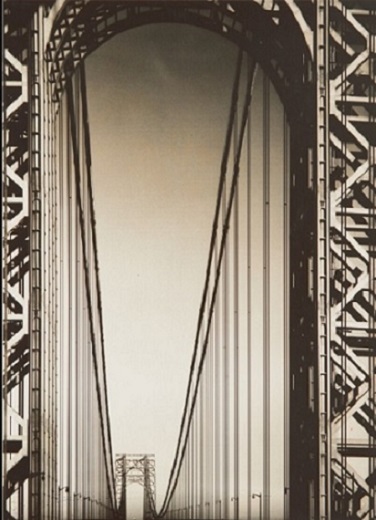
Margaret Bourke-White
American, 1904-1971
The George Washington Bridge, 1933
vintage gelatin silver print, (taped on buff colored paper)
14 1/2 × 8 3/4 in.
SBMA, Gift of the Charles Newman Trust
2017.44.3

undated photo, Life Magazine
“Nothing attracts me like a closed door. I cannot let my camera rest until I have pried it open.” – Margaret Bourke-White
COMMENTS
Spanning the Hudson River between New Jersey and upper Manhattan, the George Washington Bridge was the longest suspension bridge in existence when completed in 1931. Bourke-White translates this vast structure into a condensed recession of upright suspension wires, diminishing into the distance and terminating in the bridge’s second tower. Framing the view within the soaring arc of the first tower, Bourke-White emphasizes the beauty of modern construction as much as its scale. Intended for an essay in Fortune magazine, the photograph is a testament not only to industrial building but also to the new alliances between business, media, and photography.
https://www.metmuseum.org/art/collection/search/265397
Margaret Bourke-White was a landmark American photojournalist. Remembered as the first female war correspondent and the first foreign photographer permitted to document Soviet industry, she captured countless iconic images of 20th-century life, conflict, and the politicians at its center. “Photography is a very subtle thing. You must let the camera take you by the hand, as it were, and lead you into your subject,” she once reflected. Born Margaret White on June 14, 1904 in Bronx, NY, she attended several universities in her pursuit of a degree in herpetology. Although Bourke-White did not pursue a degree in photography in college, her father introduced her to the medium as a young woman. She turned her hobby into a career by opening a studio in Cleveland, where she specialized in architectural and industrial photography. She changed her name to include Bourke, her mother’s maiden name, in order to seem more professional, beginning her career in photojournalism for Fortune magazine in 1929. Over the following decades, she worked for Life magazine, documenting the Dust Bowl in the American heartland and later the concentration camps left by the Nazi regime. One of her most iconic pictures came after the World War II, when she visited India and captured Mahatma Gandhi reading peacefully in his home, mere hours before his assassination in 1948. Bourke-White died on August 27, 1971 in Stamford, CT. Today, the artist’s works are in the collections of The Museum of Modern Art in New York, the Rijksmuseum in Amsterdam, and the Cleveland Museum of Art, among others.
http://www.artnet.com/artists/margaret-bourke-white/4
SBMA CURATORIAL LABELS
This earth-bound view from the base of the marvelously soaring cables of the George Washington Bridge (which connects Manhattan to Fort Lee New Jersey), is among the legendary 20th-century photographer Margaret Bourke-White's most famous images. Bourke-White was hired by media magnate Henry Luce to record the bridge for Life magazine at a time, the 1930‘s, when industry, construction and machinery were being glorified in the visual arts for their distinct and alluring aesthetic qualities. Bourke-White's career was vast and important. Among her many distinctions. she was the first Western photographer to enter and record the Soviet Union, her photographs of the Great Depression remain incisive critiques of racial and economic inequality, and she was the first World War ll female battle photographer. Dating from the earlier years of her art, this image evinces Bourke-White's assured artistic talent at capturing the aesthetic gist of each subject matter on which she focused.
- A Time of Gifts, 2022
